JL Cross 15
RSP 11516
Grower: Kevin McKernan
General Information
- Accession Date
- June 17, 2020
- Reported Plant Sex
- not reported
- Report Type
- StrainSEEK v2 3.2Mb
- DNA Extracted From
- Unknown
The strain rarity visualization shows how distant the strain is from the other cultivars in the Kannapedia database. The y-axis represents genetic distance, getting farther as you go up. The width of the visualization at any position along the y-axis shows how many strains there are in the database at that genetic distance. So, a common strain will have a more bottom-heavy shape, while uncommon and rare cultivars will have a visualization that is generally shifted towards the top.
Chemical Information
Cannabinoid and terpenoid information provided by the grower.
Cannabinoids
No information provided.
Terpenoids
No information provided.
Genetic Information
- Plant Type
- Type II
File Downloads
The bell curve in the heterozygosity visualization shows the distribution of heterozygosity levels for cannabis cultivars in the Kannapedia database. The green line shows where this particular strain fits within the distribution. Heterozygosity is associated with heterosis (aka hybrid vigor) but also leads to the production of more variable offspring. When plants have two genetically different parents, heterozygosity levels will be higher than if it has been inbred or backcrossed repeatedly.
The ratio of reads mapped to Y-contigs to reads mapped to the whole Cannabis genome (Y-ratios) has been demonstrated to be strongly correlated with plant sex typing. This plot shows the distribution of Y-ratios for all samples in our database which were sequenced with the same method (panel or WGS) as this sample and where this sample falls in the distribution.
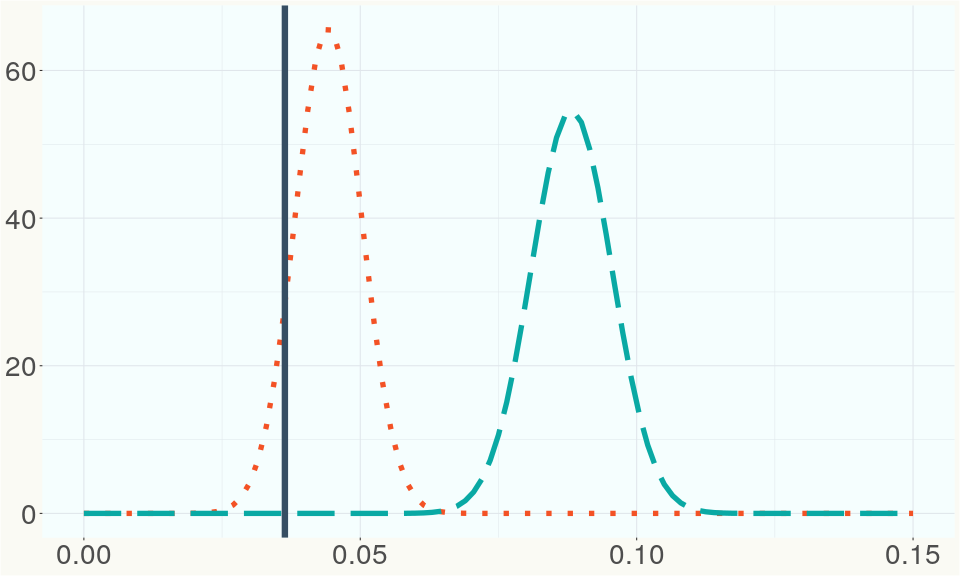
This chart represents the Illumina sequence coverage over the Bt/Bd allele. These are the three regions in the cannabis genome that impact THCA, CBDA, CBGA production. Coverage over the Active CBDAS gene is highly correlated with Type II and Type III plants as described by Etienne de Meijer. Coverage over the THCA gene is highly correlated with Type I and Type II plants but is anti-correlated with Type III plants. Type I plants require coverage over the inactive CBDA loci and no coverage over the Active CBDA gene. Lack of coverage over the Active CBDA and Active THCA allele are presumed to be Type IV plants (CBGA dominant). While deletions of entire THCAS and CBDAS genes are the most common Bt:Bd alleles observed, it is possible to have plants with these genes where functional expression of the enzyme is disrupted by deactivating point mutations (Kojoma et al. 2006).
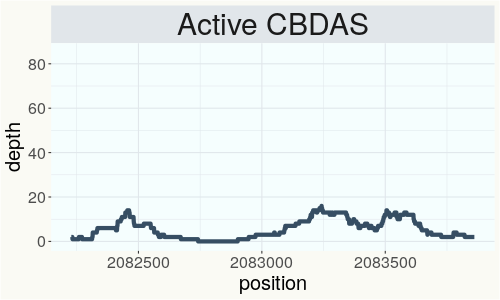
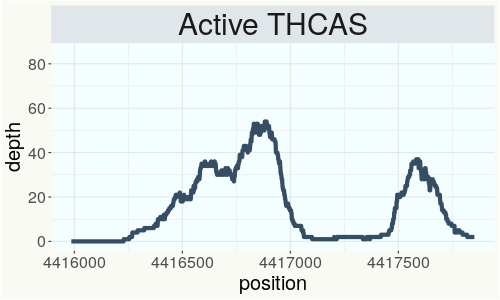
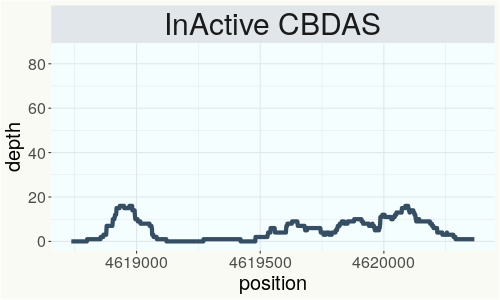
This chart represents the Illumina sequence coverage over the CBCA synthase gene.
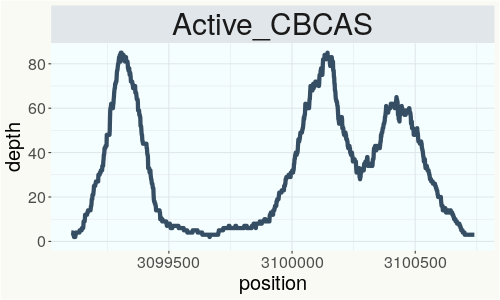
Variants (THCAS, CBDAS, and CBCAS)
No variants to report
Variants (Select Genes of Interest)
| PKSG-2a | c.67T>A | p.Phe23Ile | missense variant | moderate | contig700 | 1945567 | A/T | |
| PKSG-2a | c.31A>T | p.Thr11Ser | missense variant | moderate | contig700 | 1945603 | T/A | |
| PKSG-2b | c.1152T>A | p.Asn384Lys | missense variant | moderate | contig700 | 1950486 | A/T | |
| PKSG-2b | c.1132C>G | p.Leu378Val | missense variant | moderate | contig700 | 1950506 | G/C |
|
| PKSG-2b | c.1117A>G | p.Ile373Val | missense variant | moderate | contig700 | 1950521 | T/C | |
| PKSG-2b | c.31A>T | p.Thr11Ser | missense variant | moderate | contig700 | 1951851 | T/A | |
| PKSG-4b | c.496A>G | p.Lys166Glu | missense variant | moderate | contig700 | 2721177 | T/C | |
| PKSG-4b | c.489delT | p.Phe163fs | frameshift variant | high | contig700 | 2721183 | CA/C | |
| PKSG-4b | c.485A>G | p.Lys162Arg | missense variant | moderate | contig700 | 2721188 | T/C | |
| PKSG-4b | c.431T>G | p.Val144Gly | missense variant | moderate | contig700 | 2721242 | A/C | |
| PKSG-4b |
c.352_355del |
p.Thr118fs | frameshift variant | high | contig700 | 2721317 | CCTGT/C |
|
| PKSG-4b | c.323A>G | p.Glu108Gly | missense variant | moderate | contig700 | 2721350 | T/C |
|
| aPT4 | c.775delT | p.Tyr259fs | frameshift variant | high | contig121 | 2831380 | AT/A |
|
| aPT4 | c.1168T>C | p.Tyr390His | missense variant | moderate | contig121 | 2833503 | T/C |
|
| aPT1 | c.406A>G | p.Ile136Val | missense variant | moderate | contig121 | 2839605 | A/G | |
| aPT1 | c.629C>T | p.Thr210Ile | missense variant | moderate | contig121 | 2840237 | C/T | |
| HDS-2 |
c.82_93delGT |
p.Val28_Thr3 |
conservative inframe deletion | moderate | contig95 | 1989748 |
CGTAACCGGAAC |
|
| HDS-2 | c.127T>G | p.Ser43Ala | missense variant | moderate | contig95 | 1989794 | T/G |
|
Nearest genetic relatives (All Samples)
- 0.074 JL X NSPM1 33 (RSP11477)
- 0.079 JL X NSPM1 11 (RSP11471)
- 0.086 JL X NSPM1 5 (RSP11467)
- 0.089 JL Cross 26 (RSP11527)
- 0.089 JL x NSPM1 1 5 (RSP11479)
- 0.089 JL x NSPM1 3 (RSP11481)
- 0.090 JL Tent 4 (RSP11491)
- 0.100 JL Cross 23 (RSP11524)
- 0.104 JL Tent 1 yellow stake (RSP11488)
- 0.106 JL Cross 21 (RSP11522)
- 0.111 JL x NSPM1 2 (RSP11480)
- 0.112 JL Tent 2 (RSP11489)
- 0.117 JL Cross 2 (RSP11503)
- 0.119 JL Cross 24 (RSP11525)
- 0.120 JL X NSPM1 21 (RSP11474)
- 0.120 JL Cross 27 (RSP11528)
- 0.122 JL Cross 9 (RSP11510)
- 0.123 JL Cross 19 (RSP11520)
- 0.126 JL X NSPM1 7 (RSP11469)
- 0.129 JL X NSPM1 14 (RSP11473)
Most genetically distant strains (All Samples)
- 0.464 Cbot-2019-005 (RSP11133)
- 0.455 80E (RSP11213)
- 0.438 80E (RSP11212)
- 0.438 Northern Skunk (RSP11456)
- 0.438 Carmaleonte (RSP11207)
- 0.437 CS (RSP11208)
- 0.427 Ruderalis Indica (SRR14708267)
- 0.426 Kush Hemp E1 (RSP11128)
- 0.425 Northern Lights (RSP11501)
- 0.424 80E (RSP11211)
- 0.423 R1in136 (SRR14708226)
- 0.416 Carmagnola (RSP11202)
- 0.416 Feral (RSP11205)
- 0.415 Arcata Trainwreck (RSP11176)
- 0.414 Cherry Blossom (RSP11318)
- 0.414 R1in136 (SRR14708237)
- 0.413 Unknown--Cherry Wine---001- (RSP11268)
- 0.413 Feral (RSP10891)
- 0.411 R1in136 (SRR14708227)
- 0.411 BagSeed (RSP12627)
Nearest genetic relative in Phylos dataset
- Overlapping SNPs:
- 66
- Concordance:
- 44
Nearest genetic relative in Lynch dataset
- Overlapping SNPs:
- 3
- Concordance:
- 3
Blockchain Registration Information
- Transaction ID
-
94cfca3ba3798a1f
2b6f93590d494ce8 e04c263ffef48c24 2a8a4b823f9a005e - Stamping Certificate
- Download PDF (39.6 KB)
- SHASUM Hash
-
7082c8e88507a380c9995a82196ba857 06597fb771d9eb87 94d5f99bacda9a38